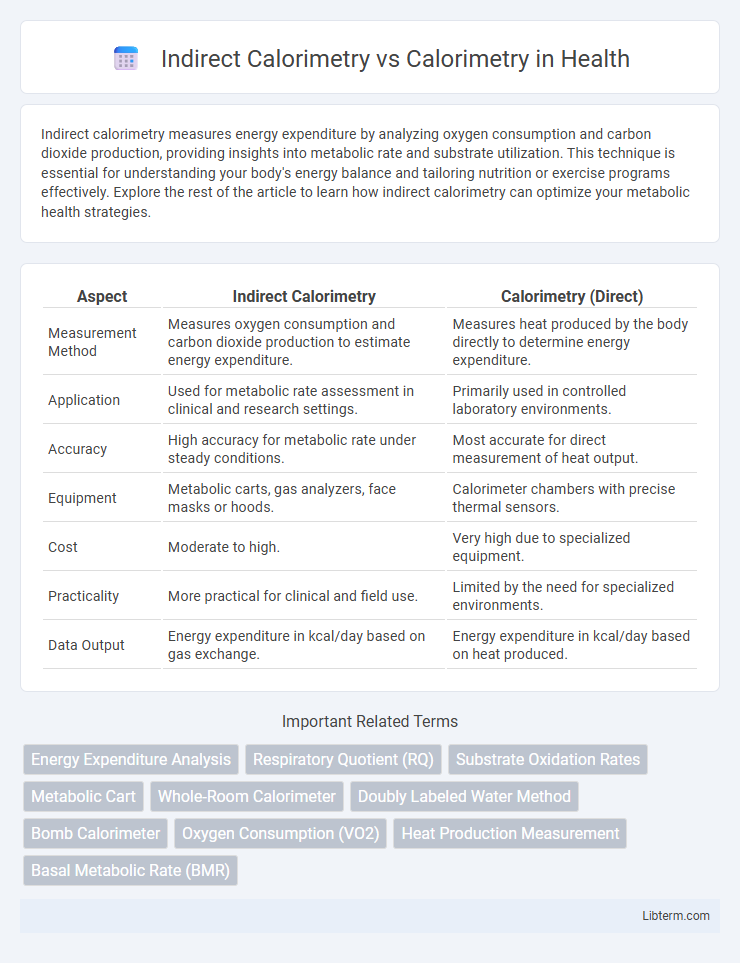Indirect calorimetry measures energy expenditure by analyzing oxygen consumption and carbon dioxide production, providing insights into metabolic rate and substrate utilization. This technique is essential for understanding your body's energy balance and tailoring nutrition or exercise programs effectively. Explore the rest of the article to learn how indirect calorimetry can optimize your metabolic health strategies.
Table of Comparison
| Aspect | Indirect Calorimetry | Calorimetry (Direct) |
|---|---|---|
| Measurement Method | Measures oxygen consumption and carbon dioxide production to estimate energy expenditure. | Measures heat produced by the body directly to determine energy expenditure. |
| Application | Used for metabolic rate assessment in clinical and research settings. | Primarily used in controlled laboratory environments. |
| Accuracy | High accuracy for metabolic rate under steady conditions. | Most accurate for direct measurement of heat output. |
| Equipment | Metabolic carts, gas analyzers, face masks or hoods. | Calorimeter chambers with precise thermal sensors. |
| Cost | Moderate to high. | Very high due to specialized equipment. |
| Practicality | More practical for clinical and field use. | Limited by the need for specialized environments. |
| Data Output | Energy expenditure in kcal/day based on gas exchange. | Energy expenditure in kcal/day based on heat produced. |
Introduction to Calorimetry
Calorimetry is the scientific measurement of heat transfer during chemical reactions or physical changes, providing critical insights into energy exchange. Indirect calorimetry estimates energy expenditure by measuring oxygen consumption and carbon dioxide production, commonly used in metabolic studies. Direct calorimetry, in contrast, measures the heat emitted directly from a subject or system, offering precise quantification of heat generation.
What is Indirect Calorimetry?
Indirect calorimetry measures energy expenditure by assessing oxygen consumption and carbon dioxide production to estimate metabolic rate, contrasting with direct calorimetry, which measures heat output directly. This method provides a non-invasive, accurate way to evaluate energy metabolism in clinical, sports, and research settings. Indirect calorimetry is widely used for assessing resting metabolic rate, nutritional needs, and metabolic disorders.
Principles of Direct Calorimetry
Direct calorimetry measures heat production by capturing and quantifying the heat dissipated from the body within a thermally insulated chamber, providing a precise assessment of metabolic rate. It relies on the principle that metabolic energy expenditure translates directly into heat, which can be measured by temperature changes in a surrounding water jacket or air flow system. Indirect calorimetry, in contrast, estimates energy expenditure by analyzing oxygen consumption and carbon dioxide production, reflecting substrate oxidation without direct heat measurement.
Key Differences Between Indirect and Direct Calorimetry
Indirect calorimetry measures energy expenditure by analyzing oxygen consumption and carbon dioxide production, providing insight into metabolic rates without direct heat measurement. Direct calorimetry quantifies energy expenditure through the accurate measurement of heat emitted by an organism, offering precise thermal output data. Key differences include the non-invasive nature and metabolic substrate oxidation analysis of indirect calorimetry versus the direct thermal energy quantification and necessity for specialized equipment inherent in direct calorimetry.
Applications of Indirect Calorimetry
Indirect calorimetry measures energy expenditure by analyzing oxygen consumption and carbon dioxide production, making it essential for assessing metabolic rates in clinical nutrition, sports science, and weight management. Unlike direct calorimetry, which quantifies heat output, indirect calorimetry offers practical applications in critically ill patients to tailor nutritional support and optimize ventilatory settings. Data from indirect calorimetry guides personalized interventions in metabolic research, improving outcomes in diabetes management and obesity treatment.
Advantages of Direct and Indirect Calorimetry
Direct calorimetry measures energy expenditure by quantifying heat production from the body, offering precise and comprehensive data on total metabolic rate. Indirect calorimetry estimates energy expenditure through respiratory gas analysis, measuring oxygen consumption and carbon dioxide production, providing a practical and non-invasive method suitable for diverse clinical and research settings. Both methods have distinct advantages: direct calorimetry delivers accurate heat measurement essential for detailed metabolic studies, while indirect calorimetry allows for easier, real-time monitoring of metabolic rates with lower operational complexity.
Limitations and Challenges
Indirect calorimetry estimates energy expenditure by measuring oxygen consumption and carbon dioxide production, but its accuracy is limited by assumptions about substrate utilization and requires controlled conditions. Direct calorimetry measures heat production directly, providing precise metabolic rates; however, it involves complex, expensive equipment and is restricted to laboratory settings. Both methods face challenges in practical application, including variability due to physical activity, environment, and individual metabolic differences.
Accuracy and Reliability Comparison
Indirect calorimetry measures energy expenditure by analyzing respiratory gases, offering high accuracy and reliability in metabolic assessments compared to direct calorimetry, which calculates heat production but is less practical and more prone to environmental interference. Studies indicate that indirect calorimetry provides precise measurements of oxygen consumption and carbon dioxide production, crucial for determining metabolic rates in clinical and research settings. Its non-invasive nature and robustness in varying conditions make indirect calorimetry the preferred method for accurate metabolic rate evaluation over direct calorimetry.
Choosing the Right Method for Research
Indirect calorimetry measures energy expenditure by analyzing oxygen consumption and carbon dioxide production, making it ideal for metabolic and physiological studies requiring non-invasive, real-time data. Direct calorimetry quantifies heat production from an organism or system, providing precise energy output measurements but generally involves more complex and costly equipment. Selecting the right method depends on research goals, with indirect calorimetry suited for continuous metabolic monitoring and direct calorimetry preferred for studies demanding exact heat measurement.
Future Trends in Calorimetry Technologies
Future trends in calorimetry technologies emphasize enhanced precision in metabolic measurement through advanced indirect calorimetry methods, integrating real-time data analytics and wearable sensors for continuous monitoring. Innovations include miniaturized, non-invasive devices capable of simultaneous gas exchange assessment and metabolic rate calculation, improving patient comfort and expanding applications in personalized health and athletic performance. The fusion of artificial intelligence with calorimetry data promises more accurate interpretation of energy expenditure, enabling tailored metabolic interventions and accelerated research in metabolic disorders.
Indirect Calorimetry Infographic

 libterm.com
libterm.com